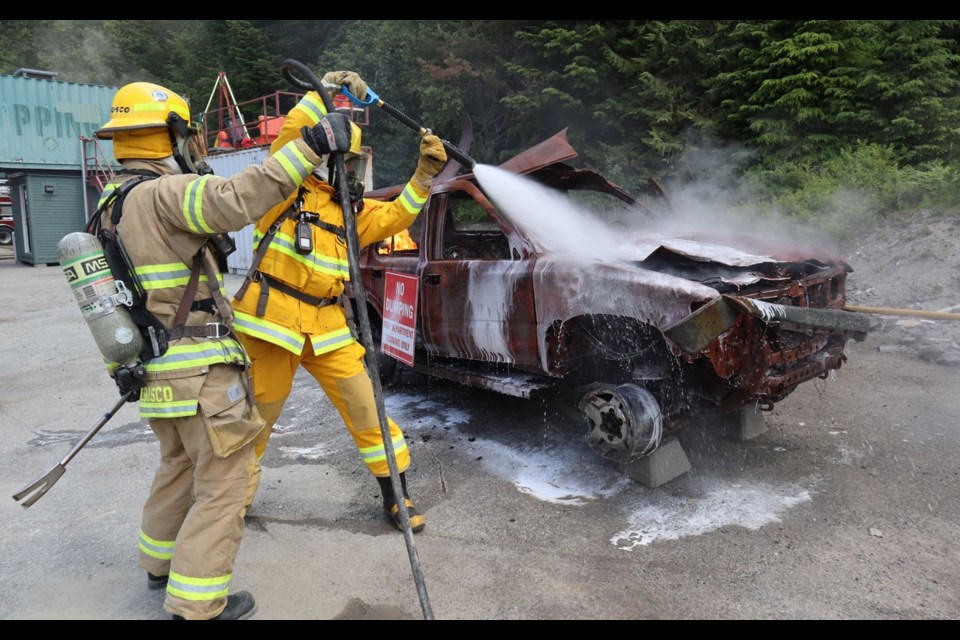Two days after participating in "Fire Ops 101" with the Whistler Fire Rescue Service (WFRS), my legs are still aching—a fact that does not at all surprise deputy fire chief Chris Nelson when I relay it to him over the phone.
"Oh yeah, you're pretty close to about 250 pounds with all the weight on," he says.
"Your gear, especially if it's wet, plus your air pack—you're probably adding another 75 pounds on your body."
That explains it.
But this reporter's intense, afternoon leg workout was just one revelation gleaned from a day spent under fire—literally—at the WFRS' training yard just south of Whistler Village off Highway 99.
Along with mayor, council and senior members of Resort Municipality of Whistler staff,
Pique was invited to spend an afternoon learning first-hand what it takes to be a firefighter directly from the men and women who keep the resort safe.
Split into groups of three, we alternated between putting out a car fire, venturing into a burn building with a live blaze underway, and rescuing an accident victim from a vehicle (in my group's case, which consisted of myself, Mayor Jack Crompton and Councillor Cathy Jewett, we used a combo of a glass punch, reciprocating saw and the awe-inspiring Jaws of Life to turn the victim's SUV into a convertible in less than 20 minutes).
"The idea is for everybody to have a real view—when they're actually engaged in some of these evolutions—of just how taxing they can be," explained WFRS chief John McKearney before the day began.
"There's an understanding that, yes, firefighters have down time, but when they're on the go, they're really on the go. It's quite physically demanding, and it's very mentally demanding."
By day's end, I can't argue with him.
My group's last evolution of the afternoon saw us hook in to our Self Contained Breathing Apparatuses and drag a four-inch fire hose into the live burn building to quell the flames.
As we ventured into the sweltering, pitch-black interior, keeping as low to the ground as possible, my visor immediately turned to moisture and my bearings were lost, the roaring flames against the back wall of the container my only guiding light.
I would find out later that the interior of the live burn structure, at floor level, was about 125 degrees (our turnout gear is built to withstand 800-degree temperatures, Nelson says; the first thing that's going to melt is the glass face piece, at about 600 or 700 degrees).
The clothes I found underneath my turnout gear when we emerged—drenched head to toe in my own sweat—confirmed that fact.
The training facility is less than six months old, though it just received accreditation from the Justice Institute of BC about a month ago, and was made possible thanks to some big cash and in-kind donations: $22,000 from the Whistler Blackcomb Foundation, $30,000 from Mike Walsh of Walsh Restorations (donated in memory of his mother, Ingrid Walsh), a state-of-the-art fire alarm panel and sprinkler system donated by Viking Fire Protection, and wiring work donated by Corporate Electric.
In Walsh's case, he had originally donated $20,000 to the cause before surprising the WFRS with an additional $10,000 during the Fire Ops training.
"I'm really a big believer in the fire department," Walsh said in a follow-up phone call.
"A lot of the firefighters, especially the paid-on-call, are trades (workers) that I work with, and I wanted to give back to the community."
It's not Walsh's first donation to the WFRS, having previously contributed $30,000 for renovations to a fire safety trailer, $10,000 for uniforms for paid-on-call staff and $3,000 for AED machines (not to mention his old, undriveable vehicles, which we so lovingly dismantled with the Jaws of Life).
He and his father, Terence, were on hand for the Fire Ops day to watch the action unfold.
"We both agreed that's been our most fun day in Whistler, and I've lived here 20 years," Walsh said. "It was unreal."




